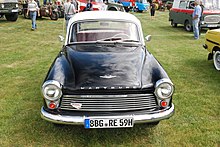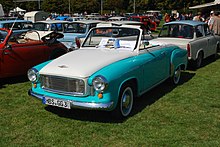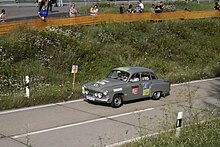War castle 312
| Wartburg | |
|---|---|
|
Wartburg 312 from 1966
|
|
| War castle 312 | |
| Production period: | 1965-1967 |
| Class : | Lower middle class |
| Body versions : | Limousine , station wagon , coupe , convertible , Kübelwagen , pickup |
| Engines: |
Otto engine : 1.0 liter (33 kW) |
| Length: | 4300 mm |
| Width: | 1590 mm |
| Height: | 1520 mm |
| Wheelbase : | 2450 mm |
| Empty weight : | 935 kg |
| Previous model | War castle 311 |
| successor | War castle 353 |
The Wartburg 312 was a passenger car from the Eisenach automobile plant , which was manufactured from 1965 to 1967. The Wartburg was an intermediate type in the transition to the new type Wartburg 353 . The type 312 is popular as a classic car because it combines the classic body of the Wartburg 311 with the coil-sprung, maintenance-free chassis of the successor type 353.
history
The 311 chassis was based on a pre-war design. Neither the hard leaf springs nor the numerous grease nipples and other maintenance points were still in keeping with the times in the 1960s. The frame construction had also become unusual. The transition to a self-supporting body was not possible due to the planning specifications laid down in 1963 . In June 1964, the high quality mark S was withdrawn from the plant because the quality of the tools had deteriorated. This made politics a little more agile; the redevelopment of the type 353 was approved. The approved development work was tackled quickly. Because current production was not able to keep up with the demand for vehicles by then, production was not stopped when the type was changed. However, the smooth transition in production made it necessary to gradually implement the new Type 353. Therefore the "intermediate type" 312 was created first. In 1966 the sedan was replaced by the type 353, station wagons and camping cars from VEB Karosseriewerke Halle remained in the range until 1967. Not only the long waiting times for new cars, but also the repair-friendly frame construction meant that Wartburg 311 and 312 were still very numerically represented in the streets of the GDR in 1989. After the fall of the Wall, most vehicles were quickly decommissioned or scrapped.
The designation 312 for the engines that were installed in the Wartburg 311/1000 from 1962 onwards causes irritation . But this has nothing to do with the vehicle, but only refers to the newly introduced 992 cc engines. Outwardly, the 312 hardly differs from its predecessor 311. In 1966, some of the vehicles were produced for a short time with a modified front mask. Only the small 13-inch wheels indicate that the vehicle in question is a Wartburg 312. The wheel cutouts of the body were not adapted to the smaller wheels.
technology
Despite the frame construction, the Type 312 had a modern chassis: independent suspension and coil springs with internal telescopic shock absorbers , at the front on double wishbones , at the rear on oblique arms (" trailing arm axle ") with transverse stabilizer , new tripod double joint shafts and load-dependent braking force limitation - things that are in the middle of the 1960s were by no means common in the lower middle class. Silent bushes and double-lubricated ball joints made it possible to achieve freedom from maintenance over 50,000 km.
Because of the difficulties in developing a rotary piston engine , the two-stroke engine still had to be used. To avoid the annoying exhaust plume, a new carburetor and an automatic fresh oil metering system have been developed. However, neither was used. After all, a more reliable ignition system with self-contained breaker cam could be implemented, as well as a new three-part exhaust system. Although this reduced the exhaust noise, it also meant that the maximum torque was only 3000 instead of the previous 2250 rpm. The steering including the steering wheel has been redesigned.
The fact that the new body was only introduced gradually created unfavorable conditions for the cooling system. The radiator had to remain behind the engine on the frame, where it received fresh air from a powerful fan that gave the typical Wartburg sound. that wasn't changed until 1985. The new cooling system was closed and maintenance-free.
Model range

As with the 311, the variety of possible bodies was largely retained. However, the proportions of total production changed considerably. While the standard sedan dominated up to now, the share of luxury sedans and camping has now increased significantly. The range also included station wagons, pickups and sedans with a steel sliding roof. There was also a hardtop coupe (HT) 312-300 , which was actually a convertible. It was produced in the VEB Karosseriewerk Dresden , where production of the previous coupé was stopped. The first examples were still built with the old 311 chassis, which is why, strictly speaking, one would have to speak of a different type 311-300 HT . Officially, however, this never existed, as the exhibition vehicle in 1965 was a Type 312. After the hardtop had been removed, an emergency cover was available in the rain. The vehicle was considered unbalanced due to the mixture of round and angular design elements. In addition, the long tail, which is atypically long for a sports car, was described by the specialist press as unfortunate. After 541 vehicles it was over - it was the last Wartburg convertible.
A total of 312 35,868 vehicles were manufactured.
Technical specifications
| Type | War castle 312 |
|---|---|
| Engine: | Three-cylinder two-stroke engine with reverse scavenging |
| Displacement: | 992 cc |
| Drilling: | 73.5 mm |
| Hub: | 78 mm |
| Compression: | 1: 7.6 |
| Power: | 45 HP (33 kW) at 4250 min -1 |
| Max. Torque: | 9.5 mkp at 2750 min −1 |
| Timing: - inlet opens - flushing opens - outlet opens |
57 ° before TDC 54 ° 50 'before UT 75 ° 10' before UT |
| Fuel octane number: | 2-stroke mixture VK 79 |
| Oil to be used: | Hyzet oil |
| Lubrication: | Fresh oil mixture lubrication |
| Mixing ratio: | 1: 33 1/3 |
| Shape of the combustion chamber | cylindrical with concentric eddy edge |
| Top speed: | 122 km / h 105 km / h (station wagon) |
| Average consumption: | 10 l / 100 km 10.5 l / 100 km (station wagon) |
| Mixture formation: | Carburetor BVF H 362-20 Wartburg-Sport: 2 × H362-1 |
| Transmission: | Four-speed gear transmission block , partially synchronized (2nd, 3rd and 4th gear) |
| Freewheel: | Can be locked manually in all forward gears, automatic lock in reverse |
| Coupling: | Single-disc dry clutch with six compression springs, completely encapsulated |
| Front axle: | Double wishbones , coil springs |
| Rear axle: | Semi-trailing arms, anti-roll bar, coil springs |
| Drive: | Tripod double cardan shafts |
| Chassis lubrication: | maintenance free |
| Brakes: | hydraulic inner shoe brake; Front duplex, rear simplex sliding shoe brakes |
| Accumulator: | 6 V, 84 Ah |
| Ignition system: | One ignition interrupter and one ignition coil per cylinder |
| Dimensions (L / W / H): | 4300/1590/1520 mm (sedan) 4350/1570/1500 mm (station wagon) 4210/1570/1450 mm (camping) 4370/1570/1440 mm (cabriolet) |
| Empty / permissible total weight: | 935/1305 kg (sedan) 1050/1445 kg (station wagon) 905/1325 kg (cabriolet) |
literature
- Michael Stück: Wartburg 311 . TIM Verlag, Berlin 1999, ISBN 3-933451-01-9
- Peter Kirchberg: Plastic, sheet metal and planned economy . Nicolaische Verlagsbuchhandlung, 2000, ISBN 3-87584-027-5
- Werner Oswald: Motor vehicles of the GDR . Motorbuch Verlag, Stuttgart 2000, ISBN 3-613-01913-2
Web links
Individual evidence
- ↑ Birger Zentner: Wartburg Kombi was at home here. In: Mitteldeutsche Zeitung . April 1, 2008, accessed June 25, 2017 .
- ^ Michael Stück: Wartburg 311. TIM Verlag, Berlin 1999, ISBN 3-933451-04-3 , page 99.





